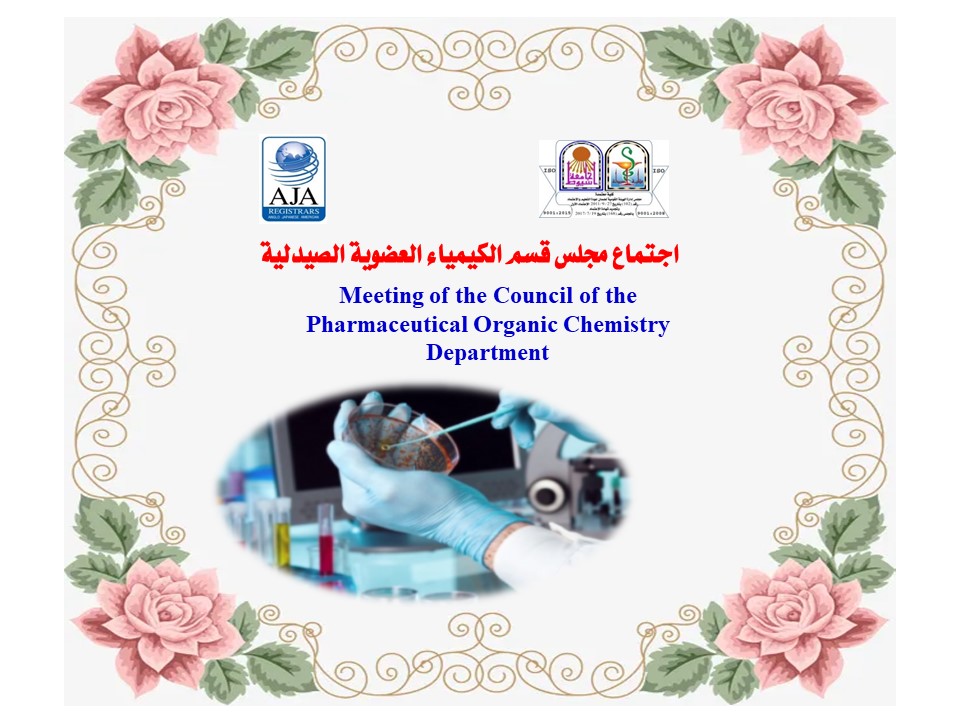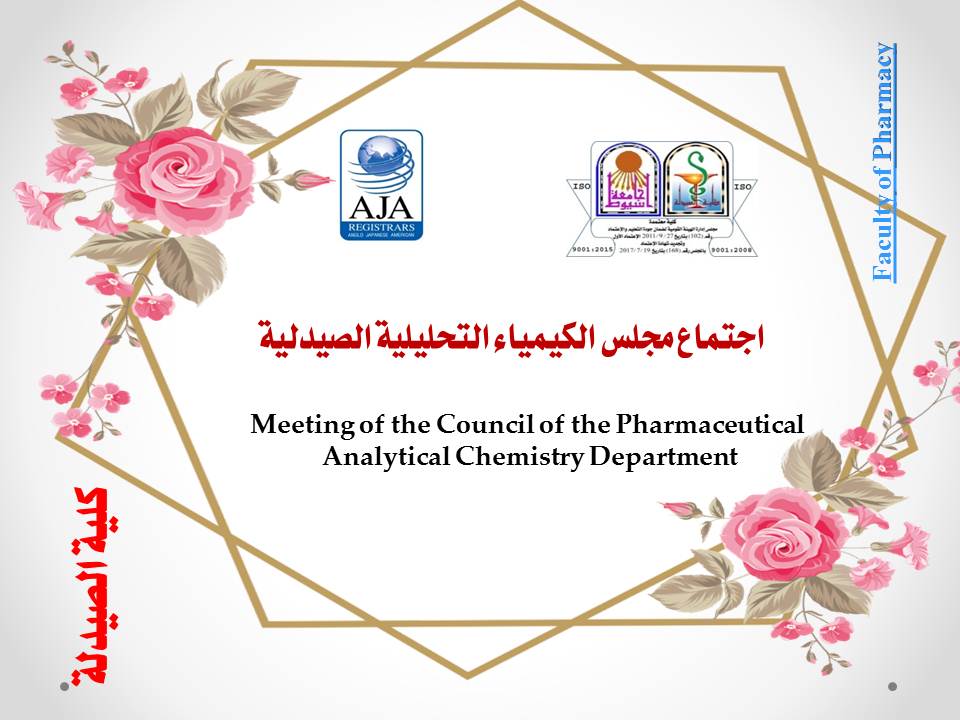
 Do you have any questions? (088) 2080369 - 2345622 Pharmacy_QAAU@pharm.aun.edu.eg
Do you have any questions? (088) 2080369 - 2345622 Pharmacy_QAAU@pharm.aun.edu.eg
Meeting of the Council of the Pharmaceutical Analytical Chemistry Department, Faculty of Pharmacy on Wednesday, August 9, 2023
Meeting of the Libraries Committee of the College of Pharmacy on Wednesday, August 9, 2023

God willing, the meeting of the Libraries Committee at the College of Pharmacy will be held on Wednesday, August 9, 2023 at 9:30 am at the invitation of Professor Dr. Ahmed Mohamed Abd El-Mawla
This meeting will be held in the office of Prof. Dr. / Dean of the College - Fifth Floor (Administrative Building).
Meeting of the Executive Committee (Clinical Pharmacy Program) on Wednesday, August 9, 2023

God willing, The Executive Committee meeting will be held on Wednesday, August 9, 2023 at ten (AM).
the Faculty Council Hall - the fifth floor (administrative building)
Dean of the Faculty
(Prof. Ahmed Mohamed Abdel Mawla)
An important announcement for students of the summer semester (Pharm D) about holding a practical exam for the pharmacognosy-2 course on Monday, August 14, 2023
An Innovative Polymer-Based Electrochemical Sensor Encrusted with Tb Nanoparticles for the Detection of Favipiravir: A Potential Antiviral Drug for the Treatment of COVID-19
An innovative polymer-based electro-sensor decorated with Tb nanoparticles has been developed for the first time. The fabricated sensor was utilized for trace determination of favipiravir (FAV), a recently US FDA-approved antiviral drug for the treatment of COVID-19. Different techniques, including ultraviolet-visible spectrophotometry (UV-VIS), cyclic voltammetry (CV), scanning electron microscope (SEM), X-ray Diffraction (XRD) and electrochemical impedance spectroscopy (EIS), were applied for the characterization of the developed electrode TbNPs@ poly mTHB/PGE. Various experimental variables, including pH, potential range, polymer concentration, number of cycles, scan rate and deposition time, were optimized. Moreover, different voltammetric parameters were examined and optimized. The presented SWV method showed linearity over the range of 10–150 × 10−9 M with a good correlation coefficient (R = 0.9994), and the detection limit (LOD) reached 3.1 × 10−9 M. The proposed method was applied for the quantification of FAV in tablet dosage forms and in human plasma without any interference from complex matrices, obtaining good % recovery results (98.58–101.93%).
NiFe‑based Prussian blue analogue nanopolygons hybridized with functionalized glyoxal polymer as a voltammetric platform for the determination of amisulpride in biological samples
A novel voltammetric platform based on pencil graphite electrode (PGE) modification has been proposed, containing bimetallic (NiFe) Prussian blue analogue nanopolygons decorated with electro-polymerized glyoxal polymer nanocomposites (p-DPG NCs@NiFe PBA Ns/PGE). Cyclic voltammetry (CV), electrochemical impedance spectroscopy (EIS), and square wave voltammetry (SWV) were utilized to investigate the electrochemical performance of the proposed sensor. The analytical response of p-DPG NCs@NiFe PBA Ns/PGE was evaluated through the quantity of amisulpride (AMS), one of the most common antipsychotic drugs. Under the optimized experimental and instrumental conditions, the method showed linearity over the range from 0.5 to 15 × 10−8 mol L−1 with a good correlation coefficient (R = 0.9995) and a low detection limit (LOD) reached, 1.5 nmol L−1, with excellent relative standard deviation for human plasma and urine samples. The interference effect of some potentially interfering substances was negligible, and the sensing platform demonstrated an outstanding reproducibility, stability, and reusability. As a first trial, the proposed electrode aimed to shed light on the AMS oxidation mechanism, where the oxidation mechanism was monitored and elucidated using the FTIR technique. It was also found that the prepared p-DPG NCs@NiFe PBA Ns/PGE platform had promising applications for the simultaneous determination of AMS in the presence of some co-administered COVID-19 drugs, which could be attributed to the large active surface area, and high conductivity of bimetallic nanopolygons.
Meeting of the Council of the Medicinal Chemistry Department, Faculty of Pharmacy on Monday, August 7, 2023

God willing, The Medicinal Chemistry Department Council will hold its regular monthly meeting number (465) on Monday, August 7, 2023 at 11:00 AM
In The Department Library
Survival and permanence for God, I am to God, and to Him we shall return.

تنعي أسرة كلية الصيدلة وفاة السيد
أحمد حسن أحمد
عامل باليومية بمزرعة قسم العقاقير
للفقيد الرحمة والمغفرة وللاسرة الصبر والسلوان
وانا لله وانا اليه راجعون
مع خالص العزاء،،،
Meeting of the Council of the Pharmaceutical Organic Chemistry Department, Faculty of Pharmacy on Tuesday, August 8, 2023

God willing, the Pharmaceutical Organic Chemistry Department Council will hold its regular monthly meeting number (464) on Tuesday, August 8, 2023 at ten in the morning
In the department council meeting room.






